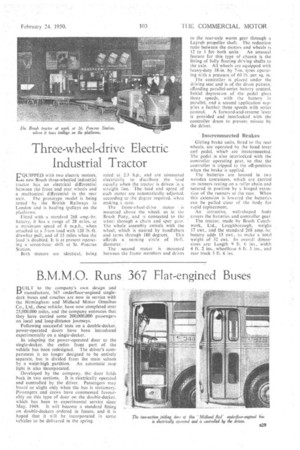Three-wheel-drive Electric Industrial Tractor
Page 63

If you've noticed an error in this article please click here to report it so we can fix it.
L'QU1PPED with two electric motors, new Brush three-wheeled industrial tractor has an electrical differential between the front and rear wheels and a mechanical differential in the rear axle. The prototype model is being tested by the British Railways . in London and is hauling crolleys on the platforms.
Fitted with a standard 268 amp.-hr, battery, it has a range of 28 miles, at
maxiinum speed of 6 m.p.h., when attached to a 3,,ton load with 120 lb,-ft. drawbar pull,. and of .15 miles when the load is doubled. It is at present operating it seven-hour shift at 'St. Paneras Station.
. Both ,motors are identical, being
rated at 2.3 h.O., and are connected electrically to distribute the load equally when the tractor is driven in a straight line. The load and speed of each motor are automatically adjusted. according to the degree required. when making a turn.
The front-wheel-drive motor • is mounted above the wheel, as in the Brush Pony, and is connected to the wheel through a chain and spur gear. The whole assembly swivels with the wheel, which is steered by handlebars and turns through 180 degrees. This affords a turning circle of 16-ft. diameter......
The second motor is mounted between the frame members and drives
to the rear-axle worm gear through a Layrub propeller shaft. The reduction ratio between the motors and wheels is
12 to 1 for both units. An unusual feature for this type of chassis is the fitting of fully floating driving shafts to the axle. All wheels are equipped with heavy-duty 18-in. by 7-in. tyres operating with a pressure of 60 lb. per sq. in.
The controller is placed under the driving seat and is of the drum pattern, affording parallel-series battery control. Initial depression of the pedal gives three speeds, with the battery in parallel, and a second application supplies a further three speeds with series control. A forward-and-reverse lever is provided and interlocked with the controller drum to prevent misuse by the driver.
Interconnected Brakes
Girling brake units, fitted to the rear wheels, are operated by the hand lever and pedal, which are interconnected. The pedal is also interlocked with the controller operating gear, so that the controller is tripped to the off-position when the brake is applied.
The batteries are housed in two wooden containers, which are carried on runners resting on a roller chain and Secured in position by a hinged extension of the runners at the rear. When Ibis extension is lowered the batteries can be pulled clear of the body for rapid replacement.
An attractive, well-shaped body covers the batteries and controller gear.
The tractor, made by Brush Coachwork, Ltd.; Loughborough, weighs 17 cwt., and the standard 268 amp,-hr. battery adds 15 cwt., to Make a total weight .of 32 cwt. its overall dimensions are: Length 9 ft. 6 ins., width 4 ft. 2 ins., wheelbase 6 ft. 3 ins., and rear track 3 ft. 6 ins.




































































































